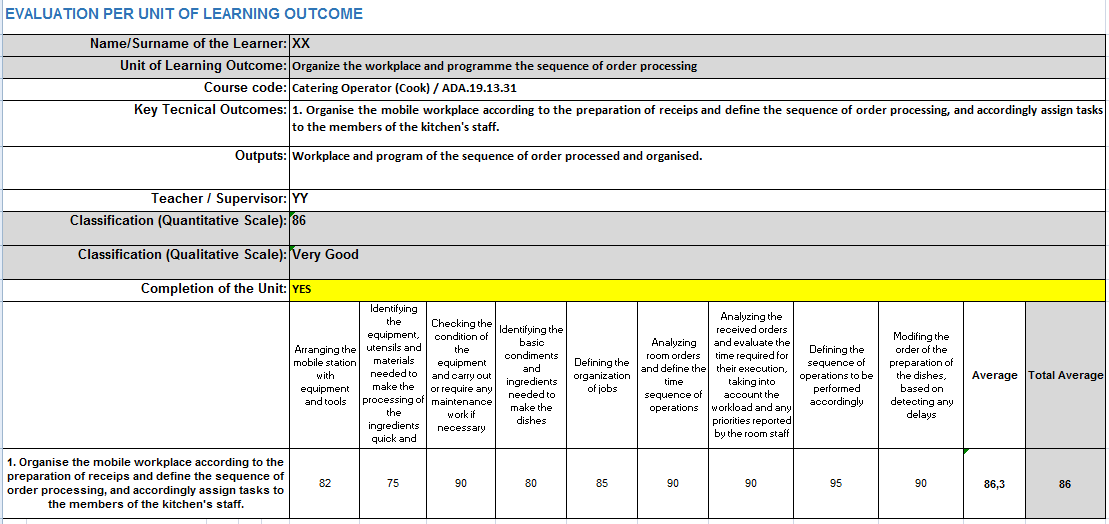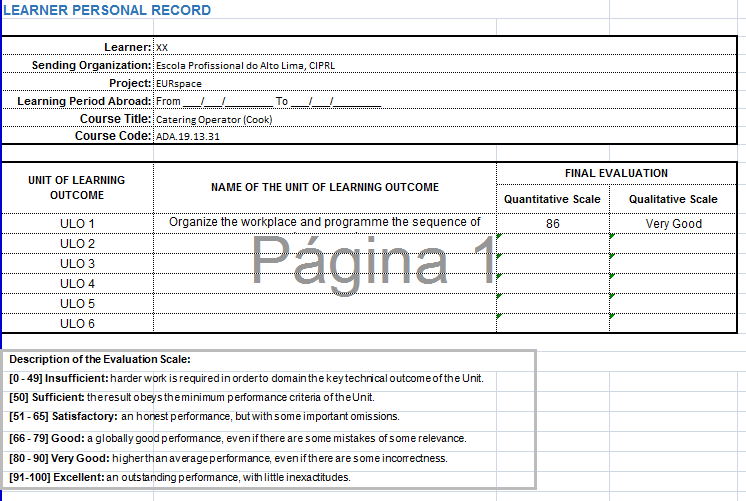- Assessment Tool for the evaluation of knowledge, skills and Competence developed in formal learning contexts
Once engaged in the learning and training activities, the learners will be assessed taking into account technical knowledge and skills as well as professional/technical competencies for each Unit of Learning Outcome agreed in the Learning Agreement.
The Assessment Tool for Units of Learning Outcome was elaborated taking into account the components of one Unit of Learning Outcome. It is a final register tool, independently of the type of evaluation used by the trainer (written test, practical test, observation grid, etc.).
The Tool is very flexible and dynamic and can be simplified or made more complex by the users. It contains several sheets: one sheet per each Unit of Learning Outcome; one sheet which summarizes all assessment data (Learner Personal Record).
The Assessment Tool for Units of Learning Outcome consists in an excel file, composed by two main sections:
► Evaluation per Unit of Learning Outcome: an excel sheet to register the evaluation results of each Unit of Learning Outcome – which can be replicated as often as necessary, depending on the number of units to be evaluated.
► Learner Personal Record: an excel sheet, linked with the evaluation results of the Units of Learning Outcome, which systematizes the evaluation of the learning period abroad – Learner Personal Record.
Here it is the direct link to access the Assessment Tool for Units of Learning Outcome.
Phase and Stage of the Pedagogical Circuit in which the Tool should be used:
Phase 2: Implementing Mobility
Stage 5: Monitoring and Evaluating
- Assessment scale and conversion between scales
A percentage assessment scale is used in the Assessment Tool for Units of Learning Outcome.
The percentage assessment scale is linked to a qualitative assessment scale, based in the Europass scale, through a simple table of conversion. The conversion to the qualitative assessment scale is done automatically in the Learner Personal Record, where the evaluation results appear in both scales.
Table 1 presents a conversion between scales: percentage scale, Europass qualitative scale, as well as the conversions for the scale of the country where the mobility takes place and the scale used in the country of origin.
Table 1: Conversion between scales.
| EVALUATION | CONVERSION TO OTHER SCALES | ||
| SCALE 1 – 100 | EUROPASS SCALE | NATIONAL SCALE | SCALE OF THE COUNTRY OF ORIGIN |
|
0 – 49 |
Insufficient – harder work is required in order to domain the key technical outcome of the Unit. |
|
|
|
50 |
Sufficient – the result obeys the minimum performance criteria of the Unit | ||
|
51 – 65 |
Satisfactory – an honest performance, but with some important omissions | ||
|
66 – 79 |
Good – a globally good performance, even if there are some mistakes of some relevance
|
||
|
80 – 90 |
Very good – higher than average performance, even if there are some incorrectness
|
||
|
91 – 100 |
Excellent – an outstanding performance, with little inexactitudes | ||
- EXAMPLE ON USING THE Assessment Tool for Units of Learning Outcome
For a better understanding, here is presented an example of the use of the Assessment Tool for Units of Learning Outcome within the context of work developed in the project EURspace.
Imagine that a given learner did a European mobility abroad:
- Country of origin: Portugal
- Country where the mobility takes place: Italy
- Sending organization: Escola Profissional do Alto Lima, CIPRL
- Receiving organization: Associazone CNOS FAP Regione Umbria
- Unit of Learning Outcome to attend in the receiving organization (agreed in the Learning Agreement): Organize the workplace and programme the sequence of order processing
By using the matching methodology applied in the project, it is expected that if the learner have a successful evaluation in the Unit Organize the workplace and program the sequence of order processing, then will have the recognition and certification of the Unit Kitchen Organization in the country of origin, with the respective allocation of 2,25 ECVET credit points.
Image 1: Assessment Tool for Units of Learning Outcome – example of the evaluation per Unit of Learning Outcome.

Image 2: Assessment Tool for Units of Learning Outcome – example of the Learner Personal Record.

The Unit of Learning Outcome designed within the project EURspace have been taken as an example for a cookery profile. Of course, the Assessment Tool for Units of Learning Outcome can be easily adapted according to the mobility needs and professional profiles.



